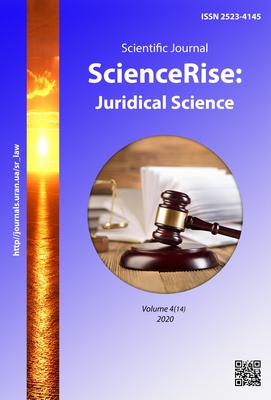Liquidation of national districts and village councils in the Ukrainian SSR in the 1930s: organizational and legal aspects
DOI:
https://doi.org/10.15587/2523-4153.2020.220832Keywords:
Ukrainian SSR, national minorities, constitutional guarantees, national administrative-territorial units, national districts and village councils, rights of national minoritiesAbstract
The article examines the organizational and legal aspects of the process of liquidation of national districts and village councils in the Ukrainian SSR in the 1930s. It was established, that the formation of national administrative-territorial units in the 1920s - early 1930s contributed to the involvement of representatives of national minorities in the main measures of Soviet state formation, the growth of their socio-economic and national-cultural level, ensuring the realization of constitutional rights of national minorities. It was found out, that at the stage of establishment of the totalitarian regime, the leadership of the USSR began to see the existence of national districts and village councils the threat of isolation of the population from the holistically built Soviet propaganda system and the impediment to the implementation of total control over society. In new Constitution of the USSR in 1936 and developed on its basis constitution of the USSR in 1937 constitutional and legal guarantees of existence of national districts and village councils disappeared, which in conditions of Soviet reality meant their rapid further elimination. It is determined, that a kind of catalyst that accelerated the process of liquidation of national administrative-territorial units was the introduction of the policy of deportations and mass political repression against representatives of national minorities in the second half of the 1930s. It is emphasized, that the requirement to eliminate national districts and village councils was adopted in December 1937 by the highest party leadership of the USSR. It was proved, that the process of liquidation of national districts and village councils in Ukraine had a number of features, due to both the deployment of the propaganda campaign for the election of the first composition of deputies of the Supreme Soviet of the USSR in the spring of 1938, and further organizational preparation for the January 1939 re-census of the population of the USSR, which led to the temporary leaving of national areas and village councils as the current administrative-territorial units. It was established, that national districts and village councils in the Ukrainian SSR ceased to exist in the spring of 1939 on the basis of the relevant resolution of the Central Committee of the Communist Party (b) and the resolution of the Presidium of the Supreme Soviet of the USSRReferences
- Panchuk, M., Voinalovych, V., Halenko, O. et. al.; Kuras, I. F. et. al. (Ed.) (2000). Natsionalni menshyny Ukrainy u KhKh stolitti: polityko-pravovyi aspekt. Kyiv: IPED, 356.
- Yakubova, L. (2004). Natsionalne administratyvno-terytorialne budivnytstvo v USRR (20-i – persha polovyna 30-kh rr. KhKh st.). Problemy istorii Ukrainy: fakty, sudzhennia, poshuky, 12, 176–224.
- Hutsalo, L. V. (2007). Natsionalne administratyvne raionuvannia na Pivdni Ukrainy (20-30-i roky XX st.). Visnyk Akademii pratsi i sotsialnykh vidnosyn Federatsii profspilok Ukrainy, 5 (42), 109–113.
- Nimtsi v Ukraini. 20-30-ti roky XX st. Zbirnyk dokumentiv derzhavnykh arkhiviv Ukrainy (1994). Kyiv: KMP «Dzhaia», 242.
- Nasiedkina, L. D. (1992). Hretski natsionalni silrady ta raiony v Ukraini (druha polovyna 20-kh – 30-i roky). Ukrainskyi istorychnyi zhurnal, 6, 64–72.
- Chornyi, S. M. (2001). Natsionalnyi sklad naselennia Ukrainy v XX storichchi. Kyiv, 85.
- Natsionalni menshyny v Ukraini. 1920–1930-ti roky: Istoryko-kartohrafichnyi atlas (1995). Kyiv, 104.
- Konstytutsiia (Osnovnyi zakon) Ukrainskoi Sotsialistychnoi Radianskoi Respubliky 1929 roku (1929). ZU URSR, 14, 100.
- Postanova VUTSVK vіd 19 liutogo 1925 r. «Pro nizove raionuvannia» (1925). ZU URSR, 13-14, 99.
- Natsionalni vidnosyny v Ukraini u KhKh st. Zbirnyk dokumentiv i materialiv (1994). Kyiv: Naukova dumka, 560.
- Pervoe Vseukrainskoe soveschanie po rabote sredi natsionalnykh menshinstv 8–11 ianvaria 1927 goda: stenogr. otchet, rezoliutsiia, postanovleniia i materialy (1927). Kharkiv: Izd. TSKNM pri VUTSIK, 228.
- Postanova VUTsVK ta RNK USRR vid 02.09.1930 r. «Pro likvidatsiiu okruh ta perekhid na dvostupenevu systemu upravlinnia» (1930). ZU URCR, 23, 225.
- Postanova Prezydii VUTsVK vid 17 liutoho 1935 r. «Pro sklad novykh administratyvnykh raioniv Dnipropetrovskoi oblasti» (1935). ZU URCR, 5, 23.
- RDASPI. F. 17. Op. 3. Spr. 994.
- Konstitutsiia SSSR 1936 g. (1963). Izvestiia TSIK SSSR i VTSIK, 283.
- DADO. F. P-326. Op. 1. Spr. 1021.
- DAOO. F. P-11. Op. 1. Spr. 1262.
- TsDAHO Ukrainy. F. 1. Op. 6. Spr. 462.
- Postanova TsVK URSR vid 20 kvitnia 1938 r. «Pro vyborchi okruhy po vyboram do Verkhovnoi Rady URSR» (1938). Visti TsVK URSR.
- Zvit Mandatnoi komisii do Verkhovnoi Rady URSR I-ho sklykannia (1938). Visti TsVK URSR.
- TsDAHO Ukrainy. F. 1. Op. 6. Cpr. 530.
Downloads
Published
How to Cite
Issue
Section
License
Copyright (c) 2020 Natalia Kuzmenko

This work is licensed under a Creative Commons Attribution 4.0 International License.
Our journal abides by the Creative Commons CC BY copyright rights and permissions for open access journals.
Authors, who are published in this journal, agree to the following conditions:
1. The authors reserve the right to authorship of the work and pass the first publication right of this work to the journal under the terms of a Creative Commons CC BY, which allows others to freely distribute the published research with the obligatory reference to the authors of the original work and the first publication of the work in this journal.
2. The authors have the right to conclude separate supplement agreements that relate to non-exclusive work distribution in the form in which it has been published by the journal (for example, to upload the work to the online storage of the journal or publish it as part of a monograph), provided that the reference to the first publication of the work in this journal is included.









